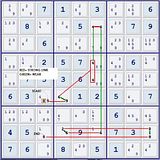It’s my understanding that if an alternating inference chain begins and ends on a strong link in the same house, you can make the following conclusion: the start value cannot be in the end cell, and the end value cannot be in the start cell.
In this puzzle the chain starts with a strong link on 9 and ends with a strong link on 8, both in the same column.
- Code: Select all
Ruud's Daily Nightmare Oct 1,2007.
007103000080050079006000000002570060000000000030012500000000600450090030000805100
*--------------------------------------------------------------------*
| 259 249 7 | 1 248 3 | 248 2458 6 |
| 123 8 134 | 26 5 46 | 234 7 9 |
| 235 24 6 | 79 248 79 | 2348 12458 12345 |
|----------------------+----------------------+----------------------|
| 189 149 2 | 5 7 489 | 3489 6 134 |
| 189 7 5 | 3 6 489 | 2489 1248 124 |
| 6 3 489 | 49 1 2 | 5 48 7 |
|----------------------+----------------------+----------------------|
| 12389 129 1389 | 47 34 147 | 6 459 458 |
| 4 5 18 | 26 9 16 | 7 3 28 |
| 7 6 39 | 8 234 5 | 1 249 24 |
*--------------------------------------------------------------------*
9[r6c3]=9[r6c4]-4[r6c4]=4[r5c6|r4c6]-4[r2c6]=6[r2c6]-6[r8c6]=6[r8c4]-2[r8c4]=2[r8c9]-8[r8c9]=8[r8c3]. 9 cannot be in end cell,8 cannot be in start cell,therefore r6c3 <> 8.
Thumbnail:

All I have to go on that this is correct is the solution, since none of my solving programs see it. Is this a legit strategy?
(BTW, I am aware there's a grouped x-cycle on 4 that accomplishes much the same thing.)

